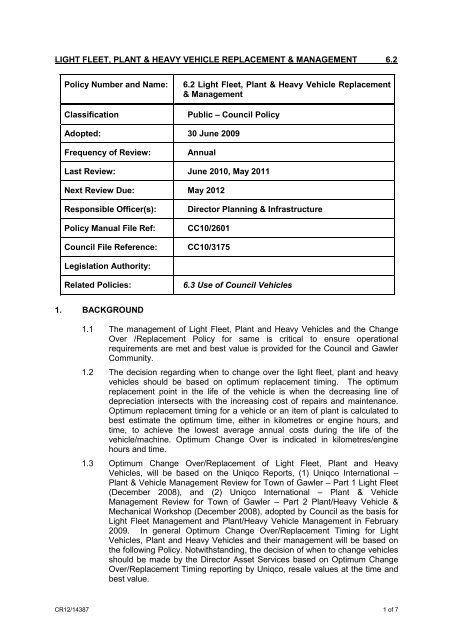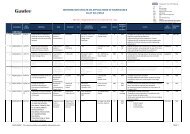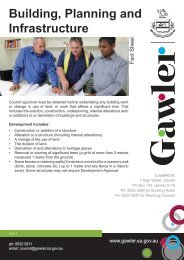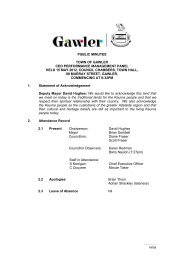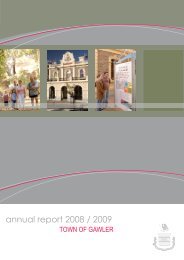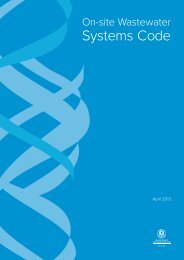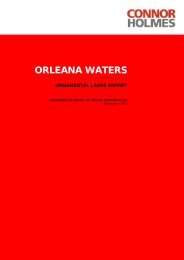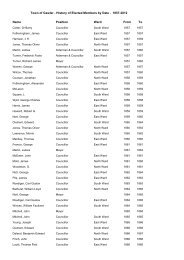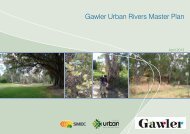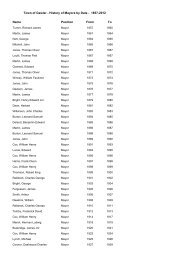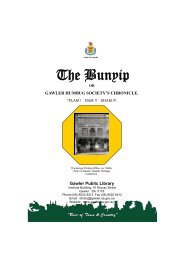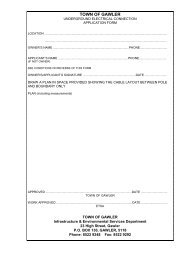LIGHT FLEET, PLANT & HEAVY VEHICLE ... - Town of Gawler
LIGHT FLEET, PLANT & HEAVY VEHICLE ... - Town of Gawler
LIGHT FLEET, PLANT & HEAVY VEHICLE ... - Town of Gawler
Create successful ePaper yourself
Turn your PDF publications into a flip-book with our unique Google optimized e-Paper software.
<strong>LIGHT</strong> <strong>FLEET</strong>, <strong>PLANT</strong> & <strong>HEAVY</strong> <strong>VEHICLE</strong> REPLACEMENT & MANAGEMENT 6.2<br />
Policy Number and Name:<br />
Classification<br />
6.2 Light Fleet, Plant & Heavy Vehicle Replacement<br />
& Management<br />
Public – Council Policy<br />
Adopted: 30 June 2009<br />
Frequency <strong>of</strong> Review:<br />
Annual<br />
Last Review: June 2010, May 2011<br />
Next Review Due: May 2012<br />
Responsible Officer(s):<br />
Policy Manual File Ref:<br />
Council File Reference:<br />
Director Planning & Infrastructure<br />
CC10/2601<br />
CC10/3175<br />
Legislation Authority:<br />
Related Policies:<br />
6.3 Use <strong>of</strong> Council Vehicles<br />
1. BACKGROUND<br />
1.1 The management <strong>of</strong> Light Fleet, Plant and Heavy Vehicles and the Change<br />
Over /Replacement Policy for same is critical to ensure operational<br />
requirements are met and best value is provided for the Council and <strong>Gawler</strong><br />
Community.<br />
1.2 The decision regarding when to change over the light fleet, plant and heavy<br />
vehicles should be based on optimum replacement timing. The optimum<br />
replacement point in the life <strong>of</strong> the vehicle is when the decreasing line <strong>of</strong><br />
depreciation intersects with the increasing cost <strong>of</strong> repairs and maintenance.<br />
Optimum replacement timing for a vehicle or an item <strong>of</strong> plant is calculated to<br />
best estimate the optimum time, either in kilometres or engine hours, and<br />
time, to achieve the lowest average annual costs during the life <strong>of</strong> the<br />
vehicle/machine. Optimum Change Over is indicated in kilometres/engine<br />
hours and time.<br />
1.3 Optimum Change Over/Replacement <strong>of</strong> Light Fleet, Plant and Heavy<br />
Vehicles, will be based on the Uniqco Reports, (1) Uniqco International –<br />
Plant & Vehicle Management Review for <strong>Town</strong> <strong>of</strong> <strong>Gawler</strong> – Part 1 Light Fleet<br />
(December 2008), and (2) Uniqco International – Plant & Vehicle<br />
Management Review for <strong>Town</strong> <strong>of</strong> <strong>Gawler</strong> – Part 2 Plant/Heavy Vehicle &<br />
Mechanical Workshop (December 2008), adopted by Council as the basis for<br />
Light Fleet Management and Plant/Heavy Vehicle Management in February<br />
2009. In general Optimum Change Over/Replacement Timing for Light<br />
Vehicles, Plant and Heavy Vehicles and their management will be based on<br />
the following Policy. Notwithstanding, the decision <strong>of</strong> when to change vehicles<br />
should be made by the Director Asset Services based on Optimum Change<br />
Over/Replacement Timing reporting by Uniqco, resale values at the time and<br />
best value.<br />
CR12/14387 1 <strong>of</strong> 7
<strong>LIGHT</strong> <strong>FLEET</strong>, <strong>PLANT</strong> & <strong>HEAVY</strong> <strong>VEHICLE</strong> REPLACEMENT<br />
& MANAGEMENT (continued) 6.2<br />
2. POLICY<br />
2.1 Part 1 – Light Fleet<br />
2.1.1 Optimum Changeover/Replacement Timing <strong>of</strong> Light Fleet<br />
2.1.1.1 Optimum Changeover <strong>of</strong> Light Fleet (based on resale value,<br />
servicing and maintenance costs, downtime costs and<br />
change over costs) be within the following range:<br />
(i) 4 cylinder cars No later than 4 years or 80,000km<br />
(ii) 4 cylinder utilities<br />
No later than 5 years or 120,000km<br />
(iii) 6 cylinder vehicles No later than 5 years or 120,000km<br />
2.1.1.2 Light Fleet not be held beyond five years due to increasing<br />
risk in terms <strong>of</strong> vehicle safety and breakdowns and<br />
increasing maintenance costs<br />
2.1.1.3 Where vehicles exceed their warranty period, purchase<br />
roadside assistance from RAA or the manufacturer <strong>of</strong> the<br />
vehicle<br />
2.1.1.4 The Director Asset Services or his or her delegate has<br />
delegated authority to change vehicles within these<br />
parameters<br />
2.1.1.5 Market data on Light Fleet vehicle changeover is reviewed<br />
every 6 months or when the vehicle is changed over via the<br />
Uniqco International Plant & Vehicle Management Bureau<br />
Service<br />
2.1.2 Light Fleet Selection Criteria<br />
2.1.2.1 4 cylinder for non operational fleet (4 or 6 cylinders for<br />
Director level and above)<br />
2.1.2.2. 4 or 6 cylinder for operational fleet subject to operational<br />
requirements<br />
2.1.2.3 Diesel or Petrol<br />
2.1.2.4 4 star or higher ANCAP rating<br />
2.1.2.5 4 star or higher Green Vehicle Guide rating for non<br />
commercial vehicles<br />
2.1.2.6 2.5 star or higher Green Vehicle Guide rating for commercial<br />
vehicles<br />
2.1.2.7 Base classification non luxury specification (Luxury<br />
specification for Director level and above)<br />
2.1.2.8 Vehicles with lowest Whole <strong>of</strong> Life Cost (WOLC) meeting the<br />
above criteria<br />
2.1.2.9 A preference for Australian manufactured vehicles.<br />
CR12/14387 2 <strong>of</strong> 7
<strong>LIGHT</strong> <strong>FLEET</strong>, <strong>PLANT</strong> & <strong>HEAVY</strong> <strong>VEHICLE</strong> REPLACEMENT<br />
& MANAGEMENT (continued) 6.2<br />
2.1.3 Choice <strong>of</strong> Fleet Vehicles<br />
2.1.3.1 When purchasing Light Fleet the Light Fleet Selection<br />
criteria outlined in clause 2.2 is used.<br />
2.1.3.2 Where utilities are required for operational purposes,<br />
passenger air bags, ABS braking and diesel fuel (if<br />
available) be included in the standard specification<br />
2.1.3.3 Four (4)cylinder vehicles for the non-operational fleet for<br />
lowest whole <strong>of</strong> life costs, reduced fuel consumption and<br />
environmental impacts and higher resale values, to reduce<br />
the overall costs <strong>of</strong> the fleet to Council.<br />
2.1.3.4 Non commercial petrol or diesel powered vehicles be<br />
considered for the non operational fleet subject to vehicle<br />
safety and environmental assessments and Whole <strong>of</strong> Life<br />
Costs (WOLC) comparisons with other vehicles.<br />
2.1.3.5 Operational light fleet vehicles will be <strong>of</strong> the commercial type<br />
unless operational requirements dictate otherwise.<br />
2.1.3.6 Employees are not <strong>of</strong>fered a choice <strong>of</strong> vehicle apart from<br />
those vehicles selected and assessed by the fleet manager<br />
as meeting Light Fleet Selection criteria and any other<br />
relevant policy provisions.<br />
2.1.3.7 Operational requirements must be a consideration in choice<br />
<strong>of</strong> Fleet Vehicles and when required light fleet vehicles can<br />
be purchased outside <strong>of</strong> the light fleet selection criteria to<br />
satisfy operational needs.<br />
2.1.4 Optional Extras<br />
The following optional extras be included/excluded in specifications for<br />
new Light Fleet Vehicles purchases<br />
Recommended for safety & resale<br />
value<br />
Air Conditioning<br />
ONLY Light Metallic Paint<br />
ONLY Rubber Floor Mats<br />
Mud Flaps Front & Rear<br />
Driver and Passenger Air Bags<br />
Cruise Control<br />
ABS Braking<br />
Stability Control<br />
Cargo Barriers for Station Wagons &<br />
Vans<br />
Not Recommended (detract from<br />
resale)<br />
Tow Pack (unless required for business<br />
use or to meet employment contract)<br />
Dark Duco<br />
Manual other than 4WD or if required for<br />
Operational purposes<br />
Solar Tint Windows<br />
Headlight & Bonnet Protector<br />
Weather Shields<br />
Reverse Warning Alarms<br />
CR12/14387 3 <strong>of</strong> 7
<strong>LIGHT</strong> <strong>FLEET</strong>, <strong>PLANT</strong> & <strong>HEAVY</strong> <strong>VEHICLE</strong> REPLACEMENT<br />
& MANAGEMENT (continued) 6.2<br />
2.2 Part 2 - Plant / Heavy Vehicle Replacement & Management<br />
2.2.1 Utilisation<br />
Plant and Heavy Vehicle Utilisation be reviewed at least bi-annually to<br />
ensure machinery is meeting budget utilisation forecasts .<br />
2.2.2 Optimum Replacement Timing<br />
Council’s changeover policies for the heavy fleet shall be line with the<br />
Optimum Replacement benchmarks recommended in the Institute <strong>of</strong><br />
Public Works Engineering Australia (IPWEA) Plant & Vehicle<br />
Management Manual (as updated refer table).<br />
The optimum replacement timing for a vehicle or an item <strong>of</strong> plant is<br />
calculated to best estimate the optimum time, in either kilometres or<br />
engine hours, and time, to achieve the lowest average annual cost<br />
during the life <strong>of</strong> the machine.<br />
The optimum replacement point in the life <strong>of</strong> the plant item is near<br />
when the decreasing line <strong>of</strong> depreciation intersects with the increasing<br />
cost <strong>of</strong> repairs and<br />
maintenance costs. Actual depreciation figures will show two distinct<br />
steep drops in resale value. The first significant drop is immediately<br />
post purchase. The second drop is prior to a major component<br />
overhaul, which is when second hand buyers are aware <strong>of</strong> a large<br />
impending repair and maintenance bill.<br />
Utilisation is as critical in optimum replacement as time. Council<br />
understands the importance <strong>of</strong> replacing plant before resale values fall<br />
dramatically and repairs & maintenance costs increase. Adopting<br />
optimum replacement reduces annual plant replacement costs in the<br />
long term, reduce maintenance costs and most importantly reduce<br />
downtime in the outside operations.<br />
Optimum Replacement Timing Table:<br />
Group/Type<br />
Optimum Replacement Timing<br />
Years<br />
KM/Hrs<br />
Backhoe Loader 7 5,000<br />
Excavator 10 8,000<br />
Excavator Mini 6 5,000<br />
Forklift 10 5,000<br />
Grader 10 8,000<br />
Heavy duty Truck (HR & HC) 8 500,000<br />
Light duty Truck (LR) 6 150,000<br />
Loader 8 8,000<br />
Medium duty Truck (MR) 8 200,000<br />
Mower Front Deck 5 2,000<br />
Roller Large 10 5,000<br />
Skid Steer 5 5,000<br />
Sweeper 8 8,000<br />
Tractor Medium 8 5,000<br />
Trailer heavy 15 NA<br />
Trailer light 10 NA<br />
Wood chipper 5 5,000<br />
CR12/14387 4 <strong>of</strong> 7
<strong>LIGHT</strong> <strong>FLEET</strong>, <strong>PLANT</strong> & <strong>HEAVY</strong> <strong>VEHICLE</strong> REPLACEMENT<br />
& MANAGEMENT (continued) 6.2<br />
2.3 Part 3 – Light Fleet & Plant / Heavy Vehicle Management<br />
2.3.1 Whole <strong>of</strong> Life Costs<br />
2.3.1.1 Internal hire rates are based on whole <strong>of</strong> life costs and<br />
annual budget internal hire rates reflect full cost recovery<br />
including the cost <strong>of</strong> replacement.<br />
2.3.1.2 Depreciation charges reflect the level <strong>of</strong> funding required to<br />
replace an item at its optimum replacement point.<br />
2.3.1.3 Depreciation recovered through the recharge rate is<br />
classified as “over-recovery” and transferred directly to the<br />
plant replacement reserve to ensure the funds are available<br />
to fund the 10 year replacement program for plant and<br />
heavy vehicles.<br />
2.3.1.4 Whole <strong>of</strong> life costs be used in purchasing decisions for items<br />
over $10,000.<br />
2.3.2 Maintenance Failure Records<br />
Accurate recording <strong>of</strong> Maintenance Failures be undertaken by the<br />
Fleet/Plant & Workshop Operations Officer.<br />
2.3.3 Downtime<br />
Accurate recording <strong>of</strong> all downtime be undertaken by the Fleet/Plant &<br />
Workshop Operations Officer.<br />
2.3.4 Provision <strong>of</strong> Mechanical Services<br />
The model for the delivery <strong>of</strong> mechanical services is based on the<br />
following;<br />
2.3.4.1 Light Fleet Servicing be outsourced, but within a Service<br />
Level Agreement (SLA).<br />
2.3.4.2 When Heavy Plant is purchased at tender a service contract<br />
option by the supplier be included as part <strong>of</strong> the tender.<br />
2.3.4.3 Wherever practicable, external service providers conduct<br />
servicing at the <strong>Town</strong> <strong>of</strong> <strong>Gawler</strong>.<br />
2.3.4.4 Service Level Agreements are put in place with external<br />
service providers including industry flat rates for scheduled<br />
services and maintenance.<br />
2.3.4.5 The role <strong>of</strong> in-house mechanical repairs/services be focused<br />
on preventative maintenance including minor scheduled<br />
services, safety checks, emergency repairs, and small plant<br />
servicing, together with administration associated with the<br />
Plant & Fleet & Workshop.<br />
2.3.4.6 A backup arrangement is provided for when the mechanic is<br />
on extended periods <strong>of</strong> leave.<br />
2.3.4.7 For new and replacement plant and vehicle purchases,<br />
contract maintenance be included as part <strong>of</strong> the tender<br />
specification.<br />
2.3.4.8 Feedback to Operational Co-ordinators is provided on the<br />
reasons for failures, if failures are due to either the operator<br />
or inappropriate use <strong>of</strong> the item.<br />
CR12/14387 5 <strong>of</strong> 7
<strong>LIGHT</strong> <strong>FLEET</strong>, <strong>PLANT</strong> & <strong>HEAVY</strong> <strong>VEHICLE</strong> REPLACEMENT<br />
& MANAGEMENT (continued) 6.2<br />
2.3.5 Maintenance Standards & Specifications<br />
The planned and preventative maintenance schedules detailed in<br />
Table 5, Uniqco International – Plant & Vehicle Management Review<br />
for <strong>Town</strong> <strong>of</strong> <strong>Gawler</strong> – Part 2 Plant/Heavy Vehicle & Mechanical<br />
Workshop (December 2008), be utilised as the <strong>Town</strong> <strong>of</strong> <strong>Gawler</strong><br />
Maintenance Standards to minimise OH&S Risk & downtime.<br />
2.3.6 Minor Plant<br />
(a)<br />
(b)<br />
2.3.7 Risk<br />
A separate budget allocation is made for ancillary or minor plant.<br />
Each item <strong>of</strong> minor plant be serviced at least annually and<br />
checked (safety), every six months.<br />
To minimise risk the items listed in Section 2.4 & 2.5 <strong>of</strong> Uniqco<br />
International – Plant &<br />
Vehicle Management Review for <strong>Town</strong> <strong>of</strong> <strong>Gawler</strong> – Part 2 Plant/Heavy<br />
Vehicle & Mechanical Workshop (December 2008), be included in<br />
process and procedures.<br />
2.3.8 Service Level Agreements<br />
Customer requirements are managed through developed service level<br />
agreements with internal and external service providers.<br />
2.3.9 Tendering<br />
Purchasing be in accordance with the <strong>Town</strong> <strong>of</strong> <strong>Gawler</strong> purchasing<br />
Policy and the tender assessment criteria in the IPWEA (Institute <strong>of</strong><br />
Public Works Engineering) Plant & Vehicle Management Manual be<br />
adopted for the analysis <strong>of</strong> tenders and quotations.<br />
2.3.10 Funding the Plant & Fleet<br />
2.3.10.1 Internal Hire Rates be based on full cost recovery including<br />
provision (over recovery) funding future plant and fleet<br />
replacement.<br />
2.3.10.2 A plant reserve, fully funded by over recovery from internal<br />
hire rates be the method <strong>of</strong> financing fleet replacement and<br />
repairs together with private use contributions for Light Fleet.<br />
2.3.10.3 Where there is a lack <strong>of</strong> funding for capital replacement,<br />
consideration be given to leasing major plant items in<br />
preference to delaying plant replacement.<br />
CR12/14387 6 <strong>of</strong> 7
<strong>LIGHT</strong> <strong>FLEET</strong>, <strong>PLANT</strong> & <strong>HEAVY</strong> <strong>VEHICLE</strong> REPLACEMENT<br />
& MANAGEMENT (continued) 6.2<br />
3. REVIEW AND EVALUATION<br />
The effectiveness <strong>of</strong> this Code will be reviewed on an annual basis to ensure that its<br />
commitment to the principles <strong>of</strong> good conduct and standards <strong>of</strong> behaviour is being<br />
achieved.<br />
The Chief Executive Office will report to council on the outcome <strong>of</strong> the evaluation and<br />
if relevant make recommendations for amendments, alteration or substitution <strong>of</strong> a<br />
new Code.<br />
The Code will not be altered or substituted so as to affect a process already<br />
commenced.<br />
The Code will be reviewed after each general election <strong>of</strong> Council.<br />
4. FURTHER INFORMATION<br />
Further information about this Code can be obtained by:-<br />
Telephone: 8522 9211<br />
Fax: 8522 9212<br />
Email:<br />
council@gawler.sa.gov.au<br />
Appointment: <strong>Town</strong> Hall, 89 – 91 Murray Street, <strong>Gawler</strong><br />
Letter: PO Box 130, <strong>Gawler</strong> SA 5118<br />
5. AVAILABILITY OF CODE<br />
The code is available for inspection during ordinary business hours at the Council<br />
principal <strong>of</strong>fice, <strong>Gawler</strong> <strong>Town</strong> Hall or Library Council Offices, 89 – 91 Murray Street,<br />
<strong>Gawler</strong> or is available for the Council website at www.gawler.sa.gov.au.<br />
A copy <strong>of</strong> this Code will be provided to interested parties upon request, for a fee as<br />
contained in the Register <strong>of</strong> Fees and Charges.<br />
CR12/14387 7 <strong>of</strong> 7


